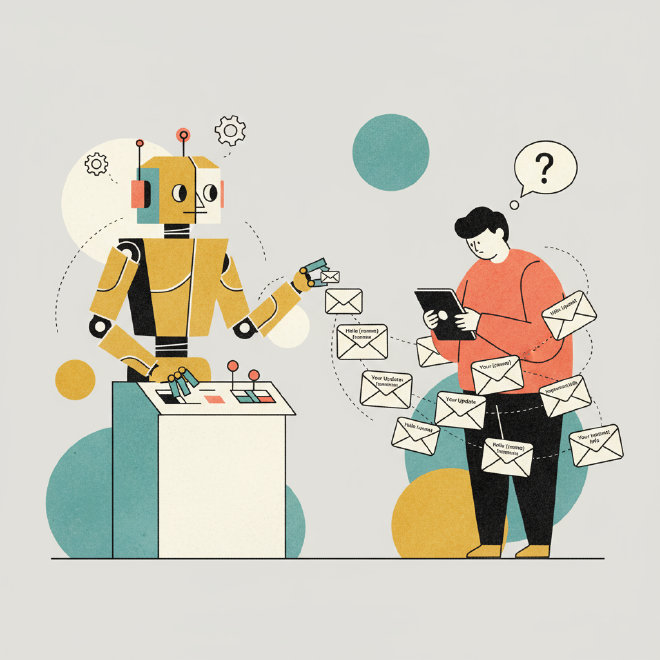4 Hidden Reasons Your Email Marketing Fails (Future-Proof for 2025)
Table of Contents
The 4 Hidden Reasons Your Email Marketing is Failing (and How to Future-Proof It for 2025) #
Email marketing isn’t dead. Far from it. In fact, it consistently boasts one of the highest ROIs in the digital marketing landscape, often cited at over $36 for every dollar spent. Yet, if you’re a small business owner or marketing pro, you might be looking at your recent campaign reports with a sigh, wondering why your emails aren’t quite hitting the mark.
You’ve probably already tweaked your subject lines, polished your copy, and even A/B tested your calls-to-action. While these are all crucial elements, the truth is, many email marketing programs struggle for deeper, less obvious reasons. These aren’t surface-level issues; they’re strategic blind spots that can silently erode your campaign’s effectiveness.
Ready to stop wondering and start winning? We’re diving deep into the four critical, often-overlooked reasons your email marketing might be failing and, more importantly, how to future-proof your strategy for 2025 and beyond.
Beyond the Inbox: Why Your Email Strategy Might Be Underperforming #
It’s easy to blame a low open rate on a boring subject line or a dismal click-through rate on weak graphics. But what if the problem lies not in the how you send, but the why and who you’re sending to? The digital landscape is noisier than ever, and generic emails simply won’t cut through. To truly improve email engagement and boost your email marketing effectiveness, we need to look under the hood.
Here are the hidden culprits sabotaging your email efforts:
Hidden Reason 1: You’re Not Evolving with Buyer Intent #

Imagine walking into a store, looking for hiking boots, and having a salesperson immediately try to sell you a fancy evening gown. Frustrating, right? That’s what many businesses do with their email marketing.
What is Buyer Intent and Why Does It Matter? #
Buyer intent goes beyond basic demographics. It’s about understanding what your subscribers are currently interested in, what problems they’re trying to solve, and where they are in their purchasing journey. Are they just browsing, comparing options, or ready to buy? This intent can shift rapidly, influenced by website visits, recent purchases, content downloads, and even how they’ve interacted with your previous emails.
The Cost of Stagnant Segmentation #
When your segmentation relies solely on initial signup data or broad categories, you’re sending static messages into a dynamic world. A subscriber who downloaded an eBook on “starting a business” a year ago might now be looking for “scaling strategies.” If you’re still sending them beginner tips, you’re not just irrelevant; you’re actively disengaging them. This leads to lower open rates, higher unsubscribes, and a significant dent in your email marketing effectiveness.
Actionable Strategy: Dynamic, Intent-Based Segmentation #
To future-proof your email marketing, embrace advanced email segmentation. Your email platform should allow you to:
- Track behavior: Monitor website pages visited, products viewed, links clicked, and content consumed.
- Leverage purchase history: Segment by past purchases, frequency, and value to offer relevant upsells, cross-sells, or loyalty rewards.
- Respond to email engagement: Create segments based on who opens, clicks, or ignores your emails to tailor future communications.
Example: Instead of a generic “new products” email, segment users who recently viewed your “eco-friendly home goods” collection and send them a tailored email featuring new arrivals within that specific category, perhaps even offering a limited-time discount. This hyper-relevance is key to a powerful email marketing strategy fix.
Hidden Reason 2: Misinterpreting Your Engagement Metrics #
“Our open rates are through the roof!” This might sound like a victory cry, but it could be a misleading siren song. Focusing on vanity metrics can give you a false sense of security while deeper problems fester.
The Open Rate Obsession Trap #
With privacy changes like Apple’s Mail Privacy Protection (MPP), open rates are no longer the reliable indicator they once were. MPP can artificially inflate open rates as it pre-fetches email content, making it seem like a user opened an email when they merely received it.
Understanding the “Why” Behind the Numbers #
True email marketing effectiveness isn’t just about if someone opened your email, but what they did next. Are they clicking? Are they converting? More importantly, are they bouncing? Are they marking your emails as spam?
- Click-Through Rate (CTR): A much stronger indicator of content relevance and call-to-action effectiveness.
- Conversion Rate: The ultimate metric – are your emails driving desired actions (purchases, sign-ups, downloads)?
- Bounce Rate: High soft bounces (temporary issues) or hard bounces (invalid addresses) signal list quality problems.
- Unsubscribe Rate & Spam Complaints: These are flashing red lights indicating your content isn’t wanted or expected.
Actionable Strategy: Holistic Performance Analysis & Real-Time Optimization #
Shift your focus from single metrics to a comprehensive view of your email performance. Your analytics dashboard should provide:
- Delivery Rates: Ensure your emails are actually reaching inboxes.
- Engagement Funnel: Track how subscribers move from open to click to conversion.
- Subscriber Health: Monitor bounce rates, unsubscribe rates, and spam complaints.
Use these insights to fuel continuous A/B testing – not just on subject lines, but on content, calls-to-action, and even send times. A robust email deliverability strategy starts with understanding the full picture of how your emails are performing.
Hidden Reason 3: Your Automation Lacks the Human Touch #

Automation is a superpower for marketers, allowing you to scale personalized communication. But if your automated sequences feel like they were written by a robot for a robot, you’re missing the point.
The Robot in the Room: Generic Automated Sequences #
We’ve all received them: the welcome series that never changes, the abandoned cart email that’s identical for every customer, the “we miss you” message that arrives weeks after you’ve already re-engaged. These “set-it-and-forget-it” automations are the antithesis of connection. They feel impersonal, generate low engagement, and often lead to unsubscribes because they lack relevance and empathy.
The Power of Humanized Automation #
Humanized email automation means creating sequences that respond dynamically to individual subscriber actions and preferences. It’s about designing an experience that feels like a one-on-one conversation, even when it’s scaled to thousands.
Think about:
- Dynamic Content: Showing different product recommendations based on browsing history.
- Behavior-Triggered Paths: Sending a specific follow-up based on whether a subscriber clicked a certain link or completed a specific action.
- Personalized Language: Moving beyond
{{first_name}}to truly reflect a subscriber’s journey and expressed interests.
Actionable Strategy: Crafting Empathetic, Interactive Journeys #
Leverage visual workflow builders to map out complex, responsive customer journeys. This isn’t just about sending emails in a linear fashion; it’s about creating “if/then” scenarios that adapt to subscriber behavior.
- Design for interaction: Incorporate polls, quizzes, or feedback requests that personalize the next step.
- Vary your content: Mix educational content with promotional offers based on where the subscriber is in their journey.
- Test and refine: Continuously optimize your automated sequences based on engagement data to ensure they always feel fresh and relevant.
Pro-Tip: Consider how interactive email content can elevate engagement. Simple embedded surveys or dynamic elements can transform a static email into an engaging experience.
Hidden Reason 4: Neglecting Consistent List Hygiene #
Your email list is an asset, but like any asset, it requires maintenance. A “dirty” list is one of the silent killers of email marketing effectiveness and can severely damage your sender reputation.
The Silent Killer of Deliverability #
What constitutes a “dirty” list? It’s a mix of:
- Invalid Email Addresses: Typos, old addresses, or deliberately fake emails.
- Spam Traps: Addresses set up by ISPs to catch senders with poor list management practices.
- Inactive Subscribers: People who haven’t opened or clicked an email in months (or years).
Sending emails to a dirty list results in high bounce rates, increased spam complaints, and ultimately, a damaged sender score. When your sender score drops, ISPs start flagging your emails as spam, meaning even your legitimate subscribers won’t see your messages. Your email deliverability strategy goes out the window.
Why “More Subscribers” Isn’t Always Better #
It’s tempting to chase subscriber numbers, but quality always trumps quantity. A smaller, highly engaged list will always outperform a massive, unmaintained list in terms of actual conversions and ROI. Sending to unengaged subscribers wastes resources and actively harms your reputation.
Actionable Strategy: Proactive List Cleaning & Reputation Management #
Make email list hygiene a non-negotiable part of your routine:
- Regularly remove hard bounces: These are permanent failures and should be scrubbed immediately.
- Re-engage or remove inactive subscribers: After a certain period (e.g., 6-12 months) of no engagement, try a re-engagement campaign. If they still don’t respond, it’s time to let them go.
- Utilize invalid address filtering: Many advanced email platforms automatically filter out known invalid addresses at the point of entry or during sends.
- Monitor your sender score: Tools exist to help you keep an eye on your reputation with ISPs.
- Implement double opt-in: This ensures every subscriber genuinely wants to receive your emails, reducing invalid addresses from the start.
This proactive approach protects your sender reputation, improves deliverability, and ensures your messages land where they matter most: in the inbox of an interested recipient.
Future-Proofing Your Email Marketing: A Roadmap for 2025 and Beyond #
The digital landscape is constantly shifting, but email remains a powerful, owned channel for building direct customer relationships. To ensure your email marketing strategy thrives in 2025 and beyond, you need to commit to:
- Understanding and responding to dynamic buyer intent.
- Analyzing comprehensive metrics to understand true engagement.
- Crafting automated journeys that feel genuinely human.
- Maintaining a clean, healthy email list.
By addressing these four hidden reasons for failure, you’re not just fixing problems; you’re building a resilient, high-performing email program that truly connects with audiences, drives measurable growth, and stands strong against evolving algorithms and user expectations. The future of email is personal, intelligent, and clean.
Ready to transform your email marketing, boost deliverability, and gain clear insights into your campaigns? Discover how intuitive tools can empower your business to connect, convert, and grow.